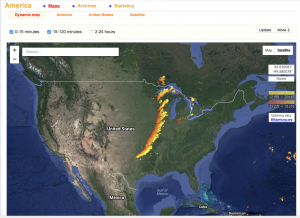LightningMaps.org is a map that shows lightning strokes around the globe in real time. The site gathers data from radio frequency signals that collect information on where lightning strokes occur. This is a community driven website so the information is crowdsourced and does not come from one specific governmental agency. Operators at radio frequency stations submit their information and the website then creates digital markers at the locations where lightning is being recorded. Due to a large network of operators sending information, the accuracy of the strokes is about one mile. This system covers specific areas in Europe, America, and Oceania. The website also stores strokes for up to 24 hours.
This website is especially interesting because amateur weather scientists can get involved recording lightning and adding to a global database. Also, this website acts as a good supplement to people who are looking to follow storms in real time. The website is easy to use with just a few buttons and four different overlays.
https://www.lightningmaps.org/blitzortung/europe/index.php?lang=en


This is a really cool website that has a lot to offer. I really like that you can see the shape and path of the storm based on where users reported lightning strikes. Although this is not helpful in predicting where lightning will strike, it could possibly give scientists clues about the intensity and size of the storm. This map does rely on user input rather than radar or ground sensors so there is always the chance that is not as accurate as it could be.
This is a fascinating website! It’s especially cool that the data is crowdsourced so that it can be verified multiple times. When I looked at the website, there were several lightning strikes recorded in the middle of the Atlantic Ocean, and I was wondering what information source provided these. Does that mean that the website is collecting data from all types of observational sources, not just the ones that directly report to them?
I think the screenshot you included is a great example of how this relates to our class, as it appears that all of those lightning strikes are following a cold front bringing storms as it moves.
This website is really interesting. I like that it is community driven, because that means that all around the world people are recording lightning strikes, which is kind of a cool idea to think about. I wish I could see this when there is a huge storm over Richmond so I could zoom in and see how often this gets updated, but all in all this is a great website.
This website is really cool because it draws on data provided by numerous operators sending information in real time and anyone can use it. Its a great tool to view lightning strikes across an area, but it does not seem too helpful in predicting weather. It would be cool if it saved strikes past 24 hours to compile a database of lightning strikes over a long period of time.
This website is interesting to me based on its accuracy to show “real-time” lightning strikes. The maps are very interactive and fun to browse around the world to see the different places that are going through current storm activity. The only criticism I would give about the website is that the website looks a bit dated and there isn’t a clear legend showing what each mark or ripple on the map indicates in terms if different lightning types or even simply just what each color depicts unless you click through specific regions on the panel on the side. It is a very cool website and a great way to work with google maps to show a satellite depiction of lightning strikes.